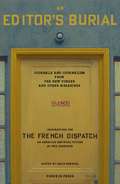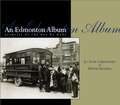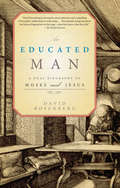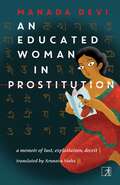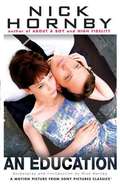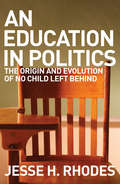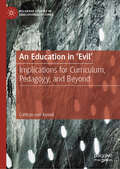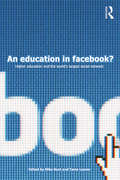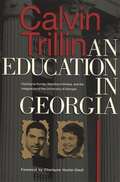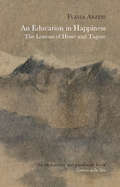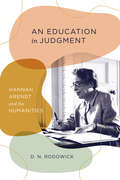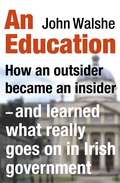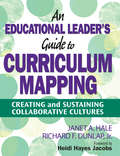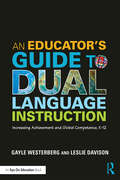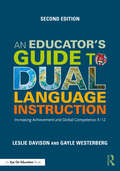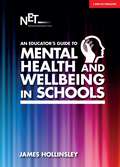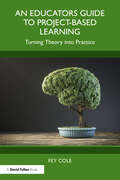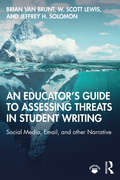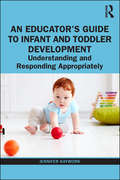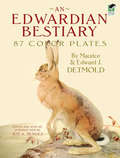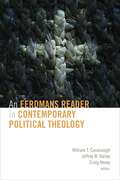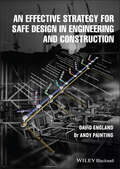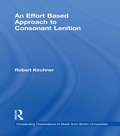- Table View
- List View
An Editor’s Burial: Journals and Journalism from the New Yorker and Other Magazines
by Various Wes AndersonA scintillating collection of inspirations for Wes Anderson's star-studded tenth film The French Dispatch--fascinating essays on the expatriate experience in Paris by some of the twentieth century's finest writers.A glimpse of post-war France through the eyes and words of 14 (mostly) expatriate journalists including Mavis Gallant, James Baldwin, A.J. Liebling, S.N. Behrman, Luc Sante, Joseph Mitchell, and Lillian Ross; plus, portraits of their editors William Shawn and New Yorker founder Harold Ross. Together: they invented modern magazine journalism. Includes an introductory interview by Susan Morrison with Anderson about transforming fact into a fiction and the creation of his homage to these exceptional reporters.
An Edmonton Album: Glimpses of the Way We Were
by Jo-Anne Christensen Dennis ShappkaThis album is a collection of sentimental journeys into Edmonton’s past - a time when a dime was all that was needed to see a movie, and couples skated across the glassy surface of a frozen lake that is now gone. These photos illustrate many important historical events and changes in Edmonton, from its fur-trading beginnings through decades of tremendous growth. Through the lens of a camera we revisit soldiers returning home from war; the first train rumbling into town; the first school, hospital, and business; the building of the Legislature and demolition of the original fort; the desperation of the "Dirty Thirties"; and the success of the initial oil boom. More than one hundred and fifty black-and-white images allow us to travel back in time to revisit Edmonton’s growth and its people. Through these photos, moments in Edmonton’s past are captured eternally, rich with details that characterize the era. An Edmonton Album is the city’s memory - in pictures.
An Educated Man: A Dual Biography of Moses and Jesus
by David RosenbergA magisterial project: a dual biography of the preeminent figures of Judeo–Christian civilization overturning conventional views of Moses and Jesus as humble men of faith.By reanimating the biographies of Moses and Jesus in their historical context, Rosenberg reads their narrative as a cultural—rather than religious—endeavor. He charges that Moses and Jesus were "educated" men, steeped in the literature and scholarship of their day. There were no old or new testaments for them, only a long history of writing and writers. When scholars and clergy quote Moses and Jesus, they routinely neglect to inform us that Jesus is quoting the Hebrew Bible, often in the manner that Moses quoted Egyptian medical texts. The remarkable ability of both men to recall and transform a wide range of sources is overlooked. Where did they get these profound educations? Part biography, part critical analysis, An Educated Man challenges us to envision what defines "an educated man or woman" today—and how understanding religious history is crucial to it. Rosenberg offers a sympathetic approach to why we need Judeo–Christianity—and ultimately convinces us that the life of Jesus is unthinkable without the model of Moses before him.
An Educated Woman In Prostitution: A Memoir of Lust, Exploitation, Deceit (Calcutta, 1929)
by Manabi Devi&‘But now, having travelled to the frontier of the world of sins, I no longer hesitated in trampling over the remnants of the goodness in my heart.&’Manada, Maani didi, Feroza Bibi, Miss Mukherjee – the jostling identities of our beguiling and charming protagonist as she glides through a life that can be seen as exploitative yet, also, curiously, empowering and honest. Manada&’s fascinating life story takes her from her wealthy cossetted upbringing to a life of debauchery and prostitution after she elopes with her married lover when in her mid-teens. She is capable, attractive and doesn&’t ask for pity as she struggles with illness, poverty and abandonment, but ensures that she emerges relatively unscathed and carves a niche for herself in her profession.Manada matures and settles into a life of prostitution, entertains barristers, doctors and other men of high society. She describes her colourful life with relish but is often introspective as she places her own position as a sex worker in the context of the times, calling out young sanctimonious patriotic men who maintain a high standing in society yet secretly fancy prostitutes. Rather tantalisingly she takes no names, only occasionally hinting at their identities, to avoid scandals and protect the double lives of men who are well-known in Calcutta in the 1920s. Weaving together multiple strands, looking beyond ideas of morality and accusations, we are presented a life of immense beauty and endurance, which is both grand in its scope and deeply intimate in its portrait.
An Education
by Nick HornbyFrom the New York Times bestselling author—the shooting script to his award-winning film, with an original Introduction and vivid stills from the movie. Jenny is a 16-year-old girl stifled by the tedium of adolescence; she can’t wait for her sophisticated adult life to begin. One rainy day her suburban existence is upended by the arrival of David, a much older suitor who introduces her to a glittering new world of concerts, art, smoky bars, urban nightlife, and his glamorous friends, replacing her traditional education with his own version. It could be her awakening—or her undoing. This edition of Hornby’s adapted screenplay, which includes stills from the film, is a perfect accompaniment to the highly anticipated movie, which stars Carey Mulligan as Jenny, Peter Sarsgaard, Emma Thompson, Dominic Cooper, and Alfred Molina. It is a must-have for fans of Hornby’s novels, featuring his signature pitch-perfect dialogue, mordant wit, and the resonant humanity of his writing. Watch a Video .
An Education In Politics
by Jesse H. RhodesSince the early 1990s, the federal role in education-exemplified by the controversial No Child Left Behind Act (NCLB)-has expanded dramatically. Yet states and localities have retained a central role in education policy, leading to a growing struggle for control over the direction of the nation's schools. In An Education in Politics, Jesse H. Rhodes explains the uneven development of federal involvement in education. While supporters of expanded federal involvement enjoyed some success in bringing new ideas to the federal policy agenda, Rhodes argues, they also encountered stiff resistance from proponents of local control. Built atop existing decentralized policies, new federal reforms raised difficult questions about which level of government bore ultimate responsibility for improving schools. Rhodes's argument focuses on the role played by civil rights activists, business leaders, and education experts in promoting the reforms that would be enacted with federal policies such as NCLB. It also underscores the constraints on federal involvement imposed by existing education policies, hostile interest groups, and, above all, the nation's federal system. Indeed, the federal system, which left specific policy formation and implementation to the states and localities, repeatedly frustrated efforts to effect changes: national reforms lost their force as policies passed through iterations at the state, county, and municipal levels. Ironically, state and local resistance only encouraged civil rights activists, business leaders, and their political allies to advocate even more stringent reforms that imposed heavier burdens on state and local governments. Through it all, the nation's education system made only incremental steps toward the goal of providing a quality education for every child.
An Education in 'Evil': Implications for Curriculum, Pedagogy, and Beyond (Palgrave Studies in Educational Futures)
by Cathryn van KesselThis book asserts that engaging with divergent understandings about the nature of evil and how it functions can help those interested in education think through issues in curriculum, pedagogy, and beyond. The author provokes thinking about and through the concept of evil in the spirit of thoughtful education (as opposed to thoughtless schooling) toward how we might live together in less harmful ways. Although thinking about evil can be uncomfortable and troubling, such inquiries help us explore what sort of relations we want to have with others. Analyzing our role in evil as humans, as well as our responsibilities to counter the processes of evil present in our everyday lives, opens up a potential to foster radical thought in and out of the classroom.
An Education in Facebook?: Higher Education and the World's Largest Social Network
by Mike Kent Tama LeaverAn Education in Facebook? examines and critiques the role of Facebook in the evolving landscape of higher education. At times a mandated part of classroom use, at others an informal network for students, Facebook has become an inevitable component of college life, acting alternately as an advertising, recruitment and learning tool. But what happens when educators use a corporate product, which exists outside of the control of universities, to educate students? An Education in Facebook? provides a broad discussion of the issues educators are already facing on college campuses worldwide, particularly in areas such as privacy, copyright and social media etiquette. By examining current uses of Facebook in university settings, this book offers both a thorough analytical critique as well as practical advice for educators and administrators looking to find ways to thoughtfully integrate Facebook and other digital communication tools into their classrooms and campuses.
An Education in Georgia: Charlayne Hunter, Hamilton Holmes, and the Integration of the University of Georgia
by Calvin TrillinIn January 1961, following eighteen months of litigation that culminated in a federal court order, Hamilton Holmes and Charlayne Hunter became the first black students to enter the University of Georgia. Calvin Trillin, then a reporter for Time Magazine, attended the court fight that led to the admission of Holmes and Hunter and covered their first week at the university--a week that began in relative calm, moved on to a riot and the suspension of the two students "for their own safety," and ended with both returning to the campus under a new court order. Shortly before their graduation in 1963, Trillin came back to Georgia to determine what their college lives had been like. He interviewed not only Holmes and Hunter but also their families, friends, and fellow students, professors, and university administrators. The result was this book--a sharply detailed portrait of how these two young people faced coldness, hostility, and occasional understanding on a southern campus in the midst of a great social change.
An Education in Happiness
by Howard Curtis Flavia ArzeniHappiness "is neither a privilege of the few, nor a fleeting state of mind: it is hidden behind a door that every person can open once they have found it, at the end of an arduous journey of self-discovery."The two Nobel Prize-winning writers Rabindranath Tagore and Hermann Hesse are arguably very different: one comes to us from the core of Indian culture, the other from the very heart of Old Europe; the former is an eternal wanderer, the latter a determined armchair traveller. Still, there are extraordinary affinities between their works, and they both understood that the path to happiness is paved with small acts and simple notions.Flavia Arzeni's book offers us an oasis of stability and calm in which we can find the answers to our fundamental concerns about life and happiness.
An Education in Judgment: Hannah Arendt and the Humanities
by D. N. RodowickIn An Education in Judgment, philosopher D. N. Rodowick makes the definitive case for a philosophical humanistic education aimed at the cultivation of a life guided by both self-reflection and interpersonal exchange. Such a life is an education in judgment, the moral capacity to draw conclusions alone and with others, and in letting one’s own judgments be answerable to the potentially contrasting judgments of others. Thinking, for Rodowick, is an art we practice with and learn from each other on a daily basis. In taking this approach, Rodowick follows the lead of Hannah Arendt, who made judgment the cornerstone of her conception of community. What is important for Rodowick, as for Arendt, is the cultivation of “free relations,” in which we allow our judgments to be affected and transformed by those of others, creating “an ever-widening fabric of intersubjective moral consideration.” That is a fragile fabric, certainly, but one that Rodowick argues is worth pursuing, caring for, and preserving. This original work thinks with and beyond Arendt about the importance of the humanities and what “the humanities” amounts to beyond the walls of the university.
An Education in Judgment: Hannah Arendt and the Humanities
by D. N. RodowickIn An Education in Judgment, philosopher D. N. Rodowick makes the definitive case for a philosophical humanistic education aimed at the cultivation of a life guided by both self-reflection and interpersonal exchange. Such a life is an education in judgment, the moral capacity to draw conclusions alone and with others, and in letting one’s own judgments be answerable to the potentially contrasting judgments of others. Thinking, for Rodowick, is an art we practice with and learn from each other on a daily basis. In taking this approach, Rodowick follows the lead of Hannah Arendt, who made judgment the cornerstone of her conception of community. What is important for Rodowick, as for Arendt, is the cultivation of “free relations,” in which we allow our judgments to be affected and transformed by those of others, creating “an ever-widening fabric of intersubjective moral consideration.” That is a fragile fabric, certainly, but one that Rodowick argues is worth pursuing, caring for, and preserving. This original work thinks with and beyond Arendt about the importance of the humanities and what “the humanities” amounts to beyond the walls of the university.
An Education: How an outsider became an insider - and learned what really goes on in Irish government
by John Walshe'Fascinating' Fintan O'Toole, Irish Times'It's a fascinating book. I ended up reading it till about four in the morning. It gives an incredible insight.' Shane Coleman, political editor, Newstalk'Excellent' Sam Smyth, Irish Mail on Sunday'A great read and I'd recommend it' Hugh Linehan, Irish Times'One of the best journalists I ever worked with ... his tell-all book is absolutely fascinating' Matt Cooper, Today FM'Like pulling back the curtains and getting a sneaky peak inside ... fascinating' Sinéad Desmond, Ireland AM, TV3After over forty years in national journalism, John Walshe thought he had seen and heard it all. That was until he got a once-in-a-lifetime opportunity to work in government and see how decisions are really made ...Having spent most of his career as an education correspondent, Walshe did not have to think twice about accepting incoming education minister Ruairi Quinn's invitation to become his special adviser. So in a matter of weeks he found himself in the seat of power in Government Buildings and up close and personal with some of the country most powerful decision-makers. It was heady stuff.An Education is John Walshe's revealing, surprising and entertaining inside account of what it's like be part of a government trying to get to grips with a country and an economy in free-fall. It is an anatomy of how choices are made, particularly when the choices are between swingeing cuts and drastic savings. And it is a gripping description of the ferocious day-to-day territorial battles and face-offs between the coalition parties and their backroom staff.Ruairi Quinn knew this would be his last cabinet post and he was determined to leave a legacy. Walshe documents the triumphs and disasters of Quinn's mission to reshape Irish education. In doing so he gets to the heart of the mix of idealism, egotism and pragmatism that ultimately drives those who govern.John Walshe's forty-month education on the corridors of power him left him much wiser about those who set out to do the state some service. His conclusions are sometimes encouraging and sometimes dismaying. But they are always enlightening. An Education is both lively and essential reading for anyone who wants to understand Irish politics in the raw.
An Educational Leader's Guide to Curriculum Mapping: Creating and Sustaining Collaborative Cultures
by Janet A. Hale Richard F. DunlapDeveloped for district leaders, curriculum directors, principals, and teacher leaders, this book shows how to lead a collaborative and sustainable curriculum mapping initiative.
An Educator's Guide to Dual Language Instruction: Increasing Achievement and Global Competence, K–12
by Gayle Westerberg Leslie DavisonThis user-friendly book is a key resource for teachers and administrators to ensure their school’s success in implementing and maintaining a dual language program. Authors Gayle Westerberg and Leslie Davison share their own experiences leading a dual language school, the obstacles they overcame, and the best practices they learned along the way. The book is filled with step-by-step instructions and strategies you can try immediately, as well as inspirational stories from educators in urban and rural dual language programs across the country. Topics include: Choosing a model for your dual language program and involving all stakeholders in the transition process; Marketing your program effectively to recruit students and staff, including international teachers; Implementing a standards-based instructional framework focused on direct vocabulary instruction, extensive reading, and using language in context; Setting proficiency targets and using internal and external assessments to track students’ progress; Incorporating technology for a more interactive and engaging language-learning experience. You’ll also learn how to effectively transition your program through different grade levels and build a collaborative school culture for a strong, long-lasting K–12 dual language program. Additional resources are available on the authors’ website, www.duallanguageinstruction.com.
An Educator's Guide to Dual Language Instruction: Increasing Achievement and Global Competence, K–12
by Gayle Westerberg Leslie DavisonComprehensively updated, the second edition is a user- friendly resource for teachers and administrators to ensure their school’s success in implementing and maintaining a dual language program. The book is filled with step-by-step instructions and strategies you can try immediately. The second edition includes key updates on technology, digital resources, and current demographics, standards, and data. Educators will learn how to choose a model for their dual language program involving all stakeholders in the transition process, set proficiency targets and use assessments to track progress, and much more.
An Educator's Guide to Mental Health and Wellbeing in Schools
by James HollinsleyA brilliant collection of essays by educators, psychologists and counsellors, highlighting the critical importance of mental health and wellbeing of students in our schools. The book has been collated and edited by James Hollinsley, Head of the Longwood Primary Academy in Essex, highly respected and awarded for their proactive approach to child mental health. An absolutely critical read for all those involved in the education of young people, the book offers: a range of best-practice case studies; searingly honest anonymous stories from survivors of poor mental health who have also been (or are) practitioners in schools; and advice from experts and specialists, including psychologists, counsellors and SEN specialists.
An Educator's Guide to Mental Health and Wellbeing in Schools
by James HollinsleyA brilliant collection of essays by educators, psychologists and counsellors, highlighting the critical importance of mental health and wellbeing of students in our schools. The book has been collated and edited by James Hollinsley, Head of the Longwood Primary Academy in Essex, highly respected and awarded for their proactive approach to child mental health. An absolutely critical read for all those involved in the education of young people, the book offers: a range of best-practice case studies; searingly honest anonymous stories from survivors of poor mental health who have also been (or are) practitioners in schools; and advice from experts and specialists, including psychologists, counsellors and SEN specialists.
An Educator's Guide to Project-Based Learning: Turning Theory into Practice
by Fey ColeAn Educator's Guide to Project-Based Learning will inspire practitioners to implement project-based learning effectively and identifies the importance of creative and innovative classrooms for highly successful educational outcomes.Project-based learning is becoming increasingly popular for research and practice. By creating the opportunity to shift from traditional methods of teaching to giving pupils ownership of their learning journey, this highly accessible book takes you through how to implement project-based learning effectively, and identifies the importance of creative and innovative classrooms for successful educational outcomes. Dipping into a range of case studies, chapters in this essential resource encourage students to gain confidence when provided with the opportunity to explore their natural curiosity. This book will also highlight how to use project-based learning across different age groups and subject areas, providing readers with insights into new learning environments and the opportunity to learn from others. Each section includes practical examples as to how to implement project-based learning and draws on the experiences of educators working in a variety of educational settings.Covering all the phases, from the Early Years to Higher Education and Adult Learning, this book will be a key resource for teachers, practitioners and educational leaders across all the stages of education.
An Educator’s Guide to Assessing Threats in Student Writing: Social Media, Email, and other Narrative
by Brian Van Brunt W. Scott Lewis Jeffrey H. SolomonBased on research from the threat-assessment community, this important resource addresses the challenge of assessing concerning online communication, written narratives, and artistic works at schools, colleges, and universities. Drawing from the collective fields of law enforcement, law, and psychology, the authors expand on evidence-based practices to help student affairs staff and K-12 educators best assess the validity of these communications and develop intervention and management plans. Concepts are supported through numerous examples of social media posts, written fiction work, emails and examples from past attacks, as well as averted plans. Appropriate for the classroom, Behavioral Intervention Teams, frontline teaching staff and administrators, this new resource will ensure an evidence-based approach to early assessment and intervention.
An Educator’s Guide to Infant and Toddler Development: Understanding and Responding Appropriately
by Jennifer KayworkAn Educator’s Guide to Infant and Toddler Development is a comprehensive and approachable guide to the growth, learning and development of children from birth to age 3. Beginning with the foundations of infant and toddler education, environments and family relationships, this essential text explores each category of development in depth. Chapters clearly explain key learning and developmental milestones, provide real-life examples and walk readers through materials and strategies for effective practice. Designed to build effective and appropriate caregiving practices, this resource is packed with reflection questions and fieldwork observations to help students continually grow their knowledge and skills. Informative, thorough and easy to use, this is a critical guide for students, caregivers and teachers helping young children to learn and grow.
An Edwardian Bestiary: 87 Color Plates
by Jeff A. Menges Maurice Detmold Edward J. DetmoldA prodigiously talented pair of English twins, the Detmold brothers shared an intense passion for drawing and observing animals. As young children, they began sketching at the Zoological Gardens in London, displayed their work at the Royal Academy by the time they were 13, and published their first book of illustrations soon after. The British art world recognized their unique gift immediately and saw them as a single creative soul residing in two bodies. Their exquisite etchings, watercolors, and pen and ink drawings, rendered in the Japanese style, are remarkable for their fine detail and vivid coloration.This glorious collection of illustrations ranges from the Detmolds' 1899 debut, Pictures from Birdland, to a 1925 edition of the exotic Arabian Nights. Other selections include curious creatures great and small from Aesop's Fables and Fabre's Book of Insects. You'll encounter a meticulously rendered menagerie that includes a slithering python and fierce tiger from The Jungle Book, a vain jackdaw with beautiful plumage, a glistening lizard and butterfly in a garden, a lace-winged praying mantis, and so much more. Collectors of fine art and beautiful books, as well as animal lovers, will treasure this distinctive art from the Golden Age of book illustration.
An Eerdmans Reader in Contemporary Political Theology
by Craig Hovey Jeffrey Bailey William T. CavanaughAn Eerdmans Reader in Contemporary Political Theology gathers some of the most significant and influential writings in political theology from the twentieth and twenty-first centuries. Given that the locus of Christianity is undeniably shifting to the global South, this volume uniquely integrates key voices from Africa, Asia, and Latin America with central texts from Europe and North America on such major subjects as church and state, gender and race, and Christendom and postcolonialism.Carefully selected, thematically arranged, and expertly introduced, these forty-nine essential readings constitute an ideal primary-source introduction to contemporary political theology — a profoundly relevant resource for globally engaged citizens, students, and scholars.CONTRIBUTORS:Nicholas AdamsRafael AvilaKarl BarthRichard BauckhamDietrich BonhoefferWalter BrueggemannErnesto CardenalJ. Kameron CarterJames H. ConeDorothy DayMusa W. Dube Jean Bethke ElshtainEric GregoryGustavo GutiérrezStanley HauerwasGeorge HunsingerAda María Isasi-DiazEmmanuel M. KatongoleRafiq KhouryKosuke KoyamaBrian McDonaldJohann Baptist Metzv Virgil MichelNéstor O. MiguezJohn MilbankJohn Courtney MurrayChed MyersH. Richard NiebuhrReinhold NiebuhrArvind P. NirmalOliver O’DonovanCatherine PickstockKwok Pui-lanA. Maria Arul RajaWalter RauschenbuschJoerg RiegerChristopher RowlandRosemary Radford RuetherAlexander SchmemannCarl SchmittPeter Manley ScottJon SobrinoDorothee SolleR. S. SugirtharajahElsa TamezMark Lewis TaylorEmilie M. TownesDesmond TutuBernd WannenwetschGraham WardGeorge WeigelDelores S. WilliamsRowan WilliamsWalter WinkJohn Howard YoderKim Yong-Bock
An Effective Strategy for Safe Design in Engineering and Construction
by David England Dr. Andy PaintingAN EFFECTIVE STRATEGY FOR SAFE DESIGN IN ENGINEERING AND CONSTRUCTION Practically and efficiently implement the Construction (Design and Management) Regulations in any project In An Effective Strategy for Safe Design, safety and risk professionals David England and Dr Andy Painting provide a comprehensive exploration of the design process, from initial idea to the validation of the product in service, from a product and project safety perspective. In that context, the authors show how the appropriate implementation of the requirements of the Construction (Design and Management) Regulations 2015 can not only improve health and safety on a project but can also improve the project’s output as well as offering savings in both capital and operational expenditure. Readers will discover how the seemingly complex matters of regulation and risk management can be practically applied to projects via examples, illustrations, and real-world references. They will find out how safety regulation, standards, and initiatives all converge on the same goal—the safest output from any given project. The book achieves three primary goals: To improve the understanding and implementation of the Construction (Design and Management) Regulations 2015 To reduce errors during the design process via the effective implementation of design management strategy To embed the concept of safety in design Perfect for designers, design managers and supervisors, project managers, surveyors, and insurers, An Effective Strategy for Safe Design is also an invaluable addition to the libraries of principal designers, specifiers, and building control officers.
An Effort Based Approach to Consonant Lenition (Outstanding Dissertations in Linguistics)
by Robert KirchnerThe first serious typological survey of the lenition process in modern phonological literature.
